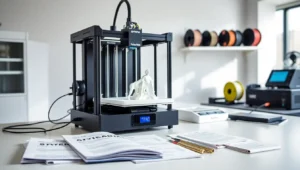In a world dominated by technology, healthcare is undergoing a seismic shift. Enter Healthcare SaaS. While the name might make you sound like a tech guru sipping coffee in a high-rise building, trust us, it’s more approachable than it sounds. Imagine streamlining medical processes, enhancing patient care, and doing it all from the comfort of your own device without the need for a million spreadsheets. That’s the magic of SaaS in healthcare, and it’s time to jump into how it is redefining medical services as we know them.
Table of Contents
ToggleUnderstanding Healthcare SaaS

Healthcare Software as a Service (SaaS) represents a smarter approach to patient management, billing, and record-keeping. Instead of clunky systems requiring extensive IT support, Healthcare SaaS offers cloud-based solutions that are quick to deploy and simple to use. This model allows healthcare providers to access applications over the internet without dealing with the pitfalls of physical servers. Just like how streaming services have changed the way we consume media, Healthcare SaaS transforms how medical professionals deliver care.
These platforms come equipped with comprehensive functionalities spanning everything from electronic health records (EHR) to telemedicine solutions. With the increasing adoption of cloud technology, the integration of these services is not merely a trend: it’s becoming the standard.
Key Features of Healthcare SaaS Solutions
When diving into the world of Healthcare SaaS, certain features stand out:
1. Scalability
As medical practices grow, their needs evolve. Healthcare SaaS solutions scale seamlessly. Whether increasing patient intake or adding new services, these platforms adapt effortlessly.
2. Security
In healthcare, protecting patient data is paramount. Robust encryption protocols combined with regular security updates ensure that sensitive information remains confidential and secure.
3. Interoperability
Healthcare SaaS systems can communicate with other software, leading to improved data sharing. This is crucial for providing accurate patient care and maintaining up-to-date medical histories.
4. User-Friendly Interfaces
Intuitive design reduces training time. Medical staff can navigate seamlessly, allowing them to focus on what they do best, caring for patients.
5. Data Analytics
Access to real-time analytics provides insights that drive well-informed choice-making, eventually leading to better patient outcomes.
Benefits of Implementing Healthcare SaaS
Implementing Healthcare SaaS can drastically change the operational landscape for medical providers. Here are some key benefits:
1. Cost Efficiency
No longer do practices need to invest heavily in hardware and software. With a subscription model, costs become predictable, making budgeting significantly easier.
2. Enhanced Patient Care
Access to real-time patient data allows healthcare providers to make informed decisions at lightning speed. Timely interventions can mean the difference between recovery and complications.
3. Remote Access
In an era of telehealth, remote access to patient records is essential. Healthcare professionals can see patient data from anywhere, facilitating better communication and follow-ups.
4. Automatic Updates
Say goodbye to the headaches of pushing out updates. Healthcare SaaS providers manage this process automatically, ensuring that systems are always up-to-date with the latest features and compliance regulations.
5. Facilitates Collaboration
Teamwork makes the dream work. Healthcare SaaS solutions break down barriers among different healthcare professionals. Easier collaboration fosters comprehensive care for patients.
Challenges and Considerations in Healthcare SaaS
Though the advantages are numerous, transitioning to Healthcare SaaS isn’t without challenges:
1. Data Privacy Concerns
Even with strong security measures, there’s always a risk. Healthcare providers must ensure that they comply with regulations, such as HIPAA, to protect patient data.
2. Integration with Existing Systems
Not all legacy systems play nicely with new SaaS solutions. Effective integration is crucial, and sometimes it can be a headache to synchronize data across platforms.
3. Dependence on Internet Connectivity
Healthcare SaaS requires robust internet access. In regions with unstable connectivity, this can pose significant challenges to service delivery.
4. User Acceptance
Change can be hard. Some staff might be resistant to new technology, making training and support essential to smooth the transition.
Future Trends in Healthcare SaaS
As technology advances, Healthcare SaaS is set for an exciting evolution:
1. Increased Use of Artificial Intelligence
AI will play a pivotal role in data analysis and patient care recommendations, freeing healthcare professionals to focus more on interaction and empathy.
2. Predictive Analytics
With the power of data, predictive analytics can help identify trends and potential health issues before they emerge, enabling proactive care.
3. Enhanced Telemedicine Features
The pandemic accelerated telehealth’s adoption. Future SaaS offerings will likely include advanced telemedicine functionalities, ensuring that care is more accessible than ever.
4. Patient-Centric Models
Expect to see more tools focused on enhancing the patient’s journey, incorporating feedback and personalized experiences to improve overall satisfaction.





